
Folsom California State Prison is a California State Prison in Folsom, California, United States, approximately 20 miles (32 km) northeast of the state capital of Sacramento. It is one of 34 adult institutions operated by the California Department of Corrections and Rehabilitation.

San Quentin Rehabilitation Center (SQ), formerly known as San Quentin State Prison, is a California Department of Corrections and Rehabilitation state prison for men, located north of San Francisco in the unincorporated place of San Quentin in Marin County.
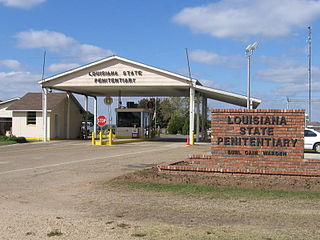
The Louisiana State Penitentiary is a maximum-security prison farm in Louisiana operated by the Louisiana Department of Public Safety & Corrections. It is named "Angola" after the former slave plantation that occupied this territory. The plantation was named after the country of Angola, from which many enslaved people originated before arriving in Louisiana.

Millard Mitchell was a Cuban-born American character actor whose credits include roughly 30 feature films and two television appearances.
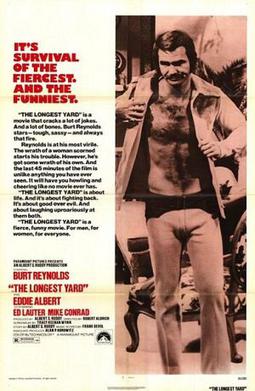
The Longest Yard is a 1974 American prison sports comedy-drama film directed by Robert Aldrich, written by Tracy Keenan Wynn, based on a story by producer Albert S. Ruddy, and starring Burt Reynolds, Eddie Albert, Ed Lauter, Michael Conrad and James Hampton. The film was released as The Mean Machine in the United Kingdom and South Africa. The film follows a former NFL player recruiting a group of prisoners and playing football against their guards. It features many real-life football players, including Ray Nitschke of the Green Bay Packers.
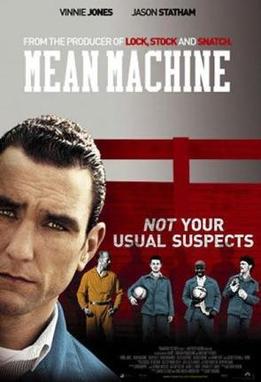
Mean Machine is a 2001 British sports comedy film directed by Barry Skolnick and starring former footballer Vinnie Jones. The film is an adaptation of the 1974 American film The Longest Yard, featuring association football rather than American football.

Escape from Alcatraz is a 1979 American prison thriller film directed and produced by Don Siegel. The screenplay, written by Richard Tuggle, is based on the 1963 non-fiction book of the same name by J. Campbell Bruce, which recounts the 1962 prisoner escape from the maximum security prison on Alcatraz Island. The film stars Clint Eastwood as escape ringleader Frank Morris, alongside Patrick McGoohan, Fred Ward, Jack Thibeau, and Larry Hankin with Danny Glover appearing in his film debut.

Hugo Geronimo Fregonese was an Argentine film director and screenwriter who worked both in Hollywood and his home country during the classical era of Argentine cinema.

Oregon State Penitentiary (OSP), also known as Oregon State Prison, is a maximum security prison in the northwest United States in Salem, Oregon. Originally opened in Portland 173 years ago in 1851, it relocated to Salem fifteen years later. The 2,242-capacity prison is the oldest in the state; the all-male facility is operated by the Oregon Department of Corrections (ODOC). OSP contains an intensive management wing, which is being transformed into a psychiatric facility for mentally ill prisoners throughout Oregon.

Menard Correctional Center, known prior to 1970 as Southern Illinois Penitentiary, is an Illinois state prison located in the town of Chester in Randolph County, Illinois. It houses maximum-security and high-medium-security adult males. The average daily population as of 2007 was 3,410.
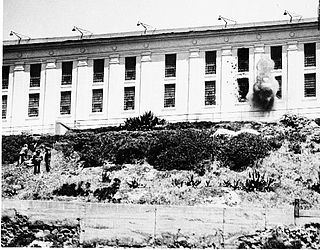
The Battle of Alcatraz, which lasted from May 2 to 4, 1946, was the result of an escape attempt at Alcatraz Federal Penitentiary by armed convicts. Two Federal Bureau of Prisons officers—William A. Miller and Harold Stites—were killed. Three inmates were also killed during the incident. Fourteen other officers and one uninvolved convict were also injured. Two of the perpetrators were executed in 1948 for their roles.
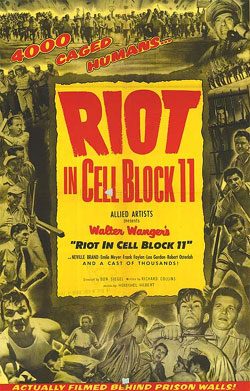
Riot in Cell Block 11 is a 1954 American film noir crime film directed by Don Siegel and starring Neville Brand, Emile Meyer, Frank Faylen, Leo Gordon and Robert Osterloh. Director Quentin Tarantino called it "the best prison film ever made."

James Aloysius Johnston was an American politician and prison warden who served as the first and longest-serving warden of Alcatraz Federal Penitentiary, serving from 1934 to 1948. He had earlier served as wardens of California state prisons at Folsom (1912-1913) and San Quentin (1914-1924).

California Correctional Institution (CCI) is a supermax state prison in the city of Tehachapi in Southern California. CCI is sometimes referred to as "Tehachapi prison" or "Tehachapi". As stated by the California Department of Corrections and Rehabilitation, its overall mission is "to incarcerate and control felons, while providing the opportunity for meaningful work, training and other programs. The prison provides programs for those inmates who are willing to work and participate fully in available programs."
Harley Oliver Teets was the warden of San Quentin State Prison from 1951 until his death in 1957. During that time he presided over executions performed in San Quentin's notorious gas chamber. Teets is probably best known for seizing the manuscript of one of condemned prisoner Caryl Chessman's books, arguing that since it was written on death row, it constituted "prison labor".
The San Quentin Six were six inmates at San Quentin State Prison in the U.S. state of California who were charged with actions related to an August 21, 1971, escape attempt that resulted in six deaths and at least two people seriously wounded. The San Quentin Six were Fleeta Drumgo, David Johnson, Hugo Pinell, Johnny Larry Spain, Willie Tate, and Luis Talamantez. The dead included George Jackson, a co-founder of the Black Guerrilla Family; two other inmates, and three guards.

The Montana State Prison is a men's correctional facility of the Montana Department of Corrections in unincorporated Powell County, Montana, about 3.5 miles (5.6 km) west of Deer Lodge. The current facility was constructed between 1974 and 1979 in response to the continued degeneration of the original facility located in downtown Deer Lodge.

The King's Thief is a 1955 swashbuckling CinemaScope adventure film directed by Robert Z. Leonard, who replaced Hugo Fregonese during filming. Released on August 5, 1955, the film takes place in London at the time of Charles II and stars Ann Blyth, Edmund Purdom, David Niven, George Sanders and Roger Moore.
The Marin County Civic Center attacks were two related attacks in 1970 at the Marin County Superior Court, located in the Marin County Civic Center in San Rafael, California, United States, tied to escalating racial tensions in the state's criminal justice system.
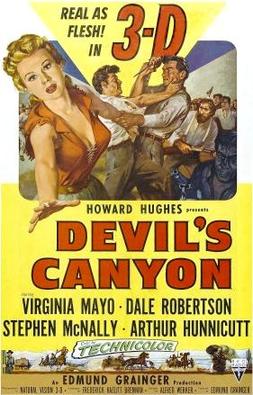
Devil's Canyon is a 1953 American Western 3-D film directed by Alfred L. Werker. The film stars Virginia Mayo, Dale Robertson, Stephen McNally and Arthur Hunnicutt.
















